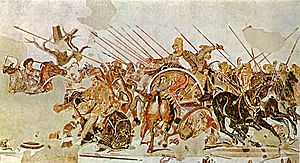Alexander Mosaic facts for kids
Quick facts for kids The Alexander Mosaic |
|
|---|---|
 |
|
| Artist | Mosaicist unknown |
| Year | c. 100 BC |
| Type | Mosaic |
| Dimensions | 272 cm × 513 cm (8 ft 11 in × 16 ft 9 in) |
| Location | National Archaeological Museum, Naples |
The Alexander Mosaic is a famous ancient Roman floor mosaic. It was found in the House of the Faun in Pompeii, an ancient city. This amazing artwork was created around 100 BC. It shows a dramatic battle between two powerful armies: those led by Alexander the Great and those of Darius III of Persia.
The mosaic is very large, measuring about 2.72 meters by 5.13 meters (that's roughly 8 feet 11 inches by 16 feet 9 inches!). The original mosaic is now kept safe at the Naples National Archaeological Museum in Italy. Experts believe this mosaic is a copy of an even older Greek painting from the 3rd century BC, possibly made by an artist named Philoxenos of Eretria.
The scene shown is the Battle of Issus, where Alexander's army fought against Darius's forces. Alexander the Great won this important battle. He won again two years later at another big battle called Gaugamela.
Contents
Who Were Alexander and Darius?
The Alexander Mosaic clearly shows the two main leaders. You can see Darius with a worried look on his face. The Persian soldiers around him also look serious and determined. Alexander, on the other hand, appears brave and ready for battle.
How Was the Mosaic Found?
This incredible mosaic was rediscovered on October 24, 1831, in the ruins of Pompeii. Pompeii was a city buried by a volcanic eruption. After its discovery, the mosaic was carefully moved to Naples in September 1843. Today, you can see it at the Museo Archeologico Nazionale.
Making a Modern Copy
In 2003, a group in Ravenna, Italy, called the International Center for the Study and Teaching of Mosaic (CISIM), decided to create an exact copy of the Alexander Mosaic. A skilled mosaic artist named Severo Bignami and his team of eight people worked on this huge project.
First, they took a very large photograph of the original mosaic. Then, they spent 22 months carefully putting together tiny pieces to make the copy. This amazing replica was finally placed in the House of the Faun in Pompeii in 2005. This means visitors to Pompeii can now see a version of the mosaic in its original home.
Gallery
See also
 In Spanish: Mosaico de Issos para niños
In Spanish: Mosaico de Issos para niños









